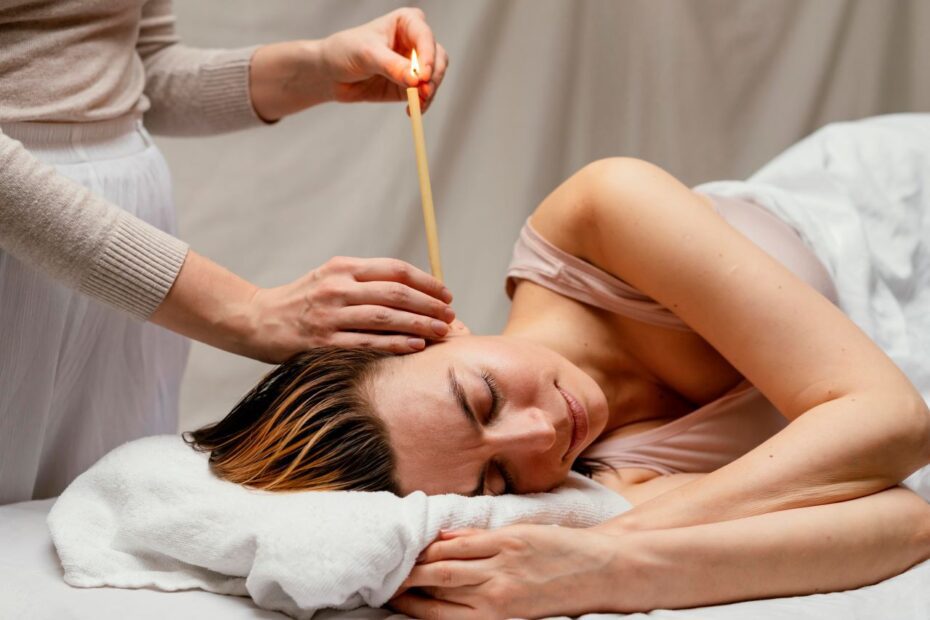What are Hopi Ear Candles?
Hopi ear candles are a tube of woven cloth that is burnt down the centre with a small opening at one end. They are rolled into a cone then placed in the ear of an individual while they lie on their side.
How do Hopi Ear Candles work?
The burning process heats up the air inside which causes it to expand, forcing out wax and other debris from inside the ear. Scientific evidence also suggests that smoke and vapour may be drawn into the inner ear by mild suction and this may also help remove wax and debris.
What does it feel like?
The individual is meant to lie on their side with the treated ear facing upwards. A flame is lit at the top of the candle and then slowly moved down to about an inch above the client’s ear canal. The client then feels a popping or crackling sensation as air inside heats up, pops and becomes pressurized. Some clients report feeling a tickling, warm sensation as well as slight pressure like someone moving air around inside their ear. Some people can also smell burning hair or even see ash left over from where smoke has been drawn into their outer ear canal.
What are the risks of the procedure?
According to Ear Candling FAQ, “candles can be dangerous if they are used improperly or by untrained people”. “One documented risk is that hot wax may drip into the ear canal during candling.”
Another major concern is that candles create an oxygen-deficient environment which allows for the possibility of burning oneself and/or starting a fire. Furthermore, individuals with existing inner ear problems such as perforated eardrums may risk causing permanent damage. There have also been reports of injuries caused by candle wax dripping onto client’s skin or hair near their face. Some individuals also report smelling burnt flesh or hair, experiencing temporary bleeding from their ear canal and even hearing loss.

Is there any scientific evidence to show that Hopi Ear Candles work?
The National Institute of Health (NIH) in the USA reported that “No controlled research has been done on the efficacy of ear candling, although many people have tried it. There are reports of burns being caused by hot wax dripping onto skin. Some users also report discomfort because of smoke seeping into the eyes”. They stated further that there is no scientific basis for believing that Hopi ear candles remove wax or debris from ears. Even though Candling International claims to be successful over 80% of the time, but in a study by the American Academy of Otolaryngology, “no such benefit was observed”.
What is a safer alternative to Hopi Ear Candles?
Ear Syringing (now known as irrigation) and microsuction is an alternative option for removing excess earwax. These procedures are often conducted by healthcare professionals like nurses, audiologists, hearing care assistants and pharmacists.
What is microsuction?
Microsuction is a gentle suction action that removes wax and debris from the ear canal.
What is irrigation?
Irrigation consists of using a special device to remove excess wax and debris with water that flows into the outer part of your ear canal. Warm water is gently directed into your ear canal which helps wash out wax and other debris.
How can I remove my earwax?
People should avoid self-removal particularly if they have existing inner or middle ear problems. Individuals should also avoid the use of commercial kits for home irrigation because without appropriate training, you may push the wax further into your ear and cause more damage than good.
Instead, contact a professional earwax removal business like Kent Wax Removal for help. It’s the most secure and efficient method to get rid of blockages in your ears.
This article was written using information obtained from:
- CNBC: Hopi Ear Candles That Promote Holistic Health Are a Hoax
- American Academy of Otolaryngology: Ear Candles – Information for Patients
- American Academy of Otolaryngology: Microsuction Fact Sheet for Consumers
- Hopi Ear Candles – Information on Health.com
- Wikipedia: Hopi Ear Candling
- WebMD: Alternative Medicine Guide to Irrigating Your Ears
- The Center for Hearing and Communication: Wax Blockage in the Ear Canal
- USA.gov Health Group. “What is Hopi ear candling?” Hopi ear candles Health Questions, n.d. Web. 18 Mar 2017.https://www.usa.gov/ear-candle.
- Science Based Medicine. “A Detailed Examination of Hopi Ear Candles.” Science Based Medicine, 13 June 2013, http://www.sciencebasedmedicine.org/a-detailed-examination-of-hopi-ear-candles/.
- National Institute of Health (U.S.). Acute Effects Associated with Use of an Ear Candle
- Ibid., Medical Treatment for Removal of Wax from the Ear
- American Academy of Otolaryngology–Head and Neck Surgery, Inc.. Irrigation (Ear) – How It’s Performed
- Cohen, M. Hopi ear candles – are they effective? . N.p.: n.p., n.d. Web. 18 Mar 2017.http://www.healthline.com/health/ear-candles.
- “Hopi.” Wikipedia, Wikimedia Foundation, 16 Mar. 2017, https://en.wikipedia.org/wiki/Hopi_Ear_Candles.
- Kelly Brogan, MD (2016). What Every Patient Needs to Know About Ear Candles. Psychology Today (online), Dec 2015
- WebMD (n.d.). Alternative Medicine Guide to Irrigating Your Ears. Retrieved from http://www.webmd.com/balance/features/alternative-medicine-guide-to-irrigating-your-ears#1
- Zamosky, L. (2013, June 13). Hopi Ear Candles – Are They Effective? Retrieved from http://www.healthline.com/health/ear-candles.
